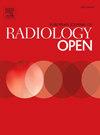超快速双参数MRI在前列腺癌评估中的应用:与常规多参数MRI相比的诊断性能和图像质量
IF 2.9
Q3 RADIOLOGY, NUCLEAR MEDICINE & MEDICAL IMAGING
引用次数: 0
摘要
目的比较深度学习辅助下的超快速双参数MRI (bpMRI)与常规多参数MRI (mpMRI)对临床显著性前列腺癌(csPCa)的诊断性能和图像质量。方法本前瞻性单中心研究纳入123例biopsy-naïve患者,于2023年6月至2024年2月期间在3 T接受常规mpMRI和超快速bpMRI。两名放射科医生(R1: 4年经验,R2: 3年经验)在两项盲法研究中独立分配PI-RADS评分(PI-RADS v2.1)并评估图像质量(mPI-QUAL评分)。计算加权科恩Kappa (κ)来评估读者间的一致性。诊断性能分析使用临床数据和组织病理学结果从临床指示活检。结果mpMRI和超快速bpMRI的读间一致性均较好(κ = 0.83)。两种读卡器均表现出高灵敏度(≥94 %/≥91 %,R1/R2)和NPV(≥96 %/≥95 %)。与经验不足的读者相比,经验丰富的读者大多表现出更高的特异性(≥77 %/≥53 %),PPV(≥62 %/≥45 %)和诊断准确性(≥82 %/≥65 %)。两种方案在正确识别csPCa的诊断性能上无显著差异(p >; 0.05)。超高速bpMRI方案具有更好的图像质量评级(p <; 0.001),与传统mpMRI相比,扫描时间减少了80% %。结论深度学习辅助的超快速bpMRI方案在诊断biopsy-naïve患者的csPCa方面具有相当的读者间一致性和更高的图像质量的诊断性能,是传统mpMRI的一个有希望的替代方案。然而,读者体验仍然是诊断性能的关键。本文章由计算机程序翻译,如有差异,请以英文原文为准。
Ultra-fast biparametric MRI in prostate cancer assessment: Diagnostic performance and image quality compared to conventional multiparametric MRI
Purpose
To compare the diagnostic performance and image quality of a deep-learning-assisted ultra-fast biparametric MRI (bpMRI) with the conventional multiparametric MRI (mpMRI) for the diagnosis of clinically significant prostate cancer (csPCa).
Methods
This prospective single-center study enrolled 123 biopsy-naïve patients undergoing conventional mpMRI and additionally ultra-fast bpMRI at 3 T between 06/2023–02/2024. Two radiologists (R1: 4 years and R2: 3 years of experience) independently assigned PI-RADS scores (PI-RADS v2.1) and assessed image quality (mPI-QUAL score) in two blinded study readouts. Weighted Cohen’s Kappa (κ) was calculated to evaluate inter-reader agreement. Diagnostic performance was analyzed using clinical data and histopathological results from clinically indicated biopsies.
Results
Inter-reader agreement was good for both mpMRI (κ = 0.83) and ultra-fast bpMRI (κ = 0.87). Both readers demonstrated high sensitivity (≥94 %/≥91 %, R1/R2) and NPV (≥96 %/≥95 %) for csPCa detection using both protocols. The more experienced reader mostly showed notably higher specificity (≥77 %/≥53 %), PPV (≥62 %/≥45 %), and diagnostic accuracy (≥82 %/≥65 %) compared to the less experienced reader. There was no significant difference in the diagnostic performance of correctly identifying csPCa between both protocols (p > 0.05). The ultra-fast bpMRI protocol had significantly better image quality ratings (p < 0.001) and achieved a reduction in scan time of 80 % compared to conventional mpMRI.
Conclusion
Deep-learning-assisted ultra-fast bpMRI protocols offer a promising alternative to conventional mpMRI for diagnosing csPCa in biopsy-naïve patients with comparable inter-reader agreement and diagnostic performance at superior image quality. However, reader experience remains essential for diagnostic performance.
求助全文
通过发布文献求助,成功后即可免费获取论文全文。
去求助
来源期刊

European Journal of Radiology Open
Medicine-Radiology, Nuclear Medicine and Imaging
CiteScore
4.10
自引率
5.00%
发文量
55
审稿时长
51 days
 求助内容:
求助内容: 应助结果提醒方式:
应助结果提醒方式:


